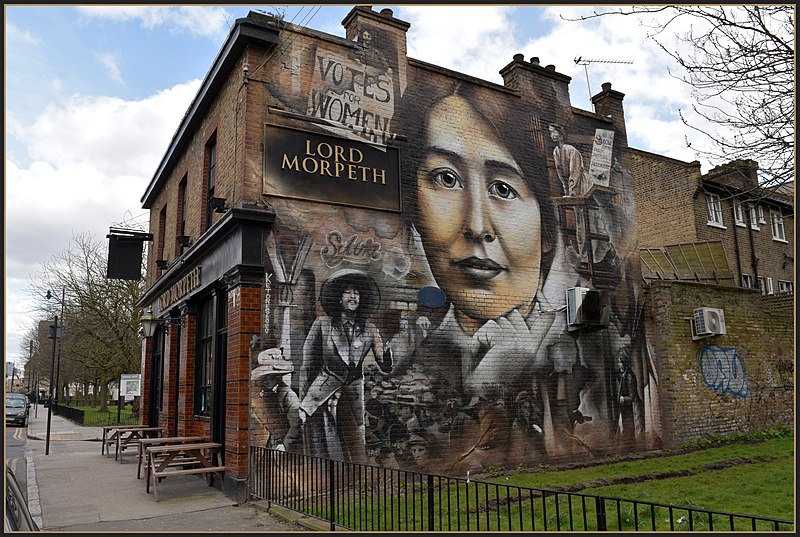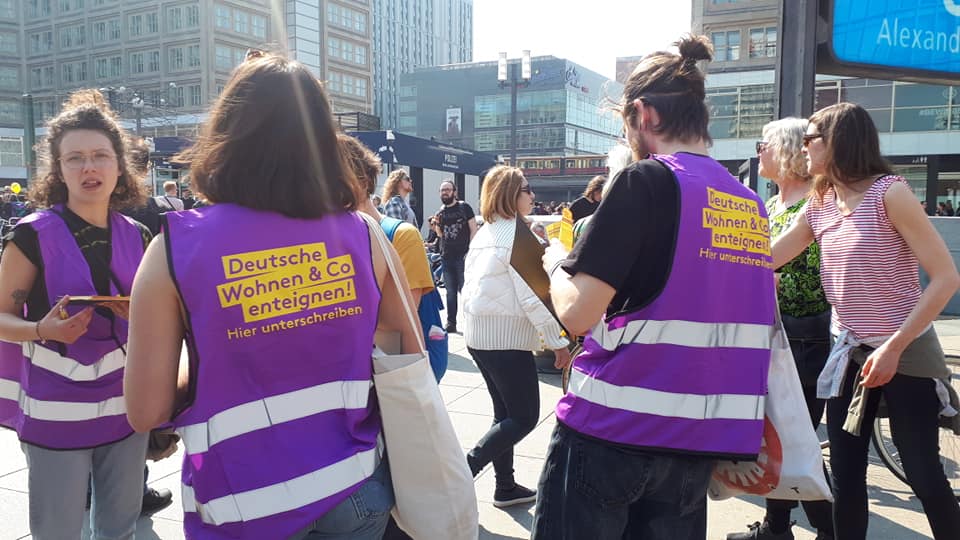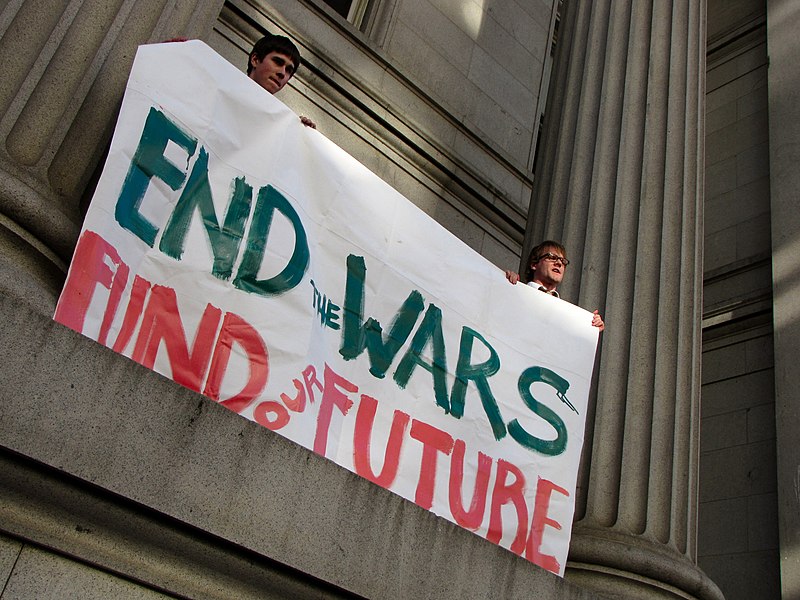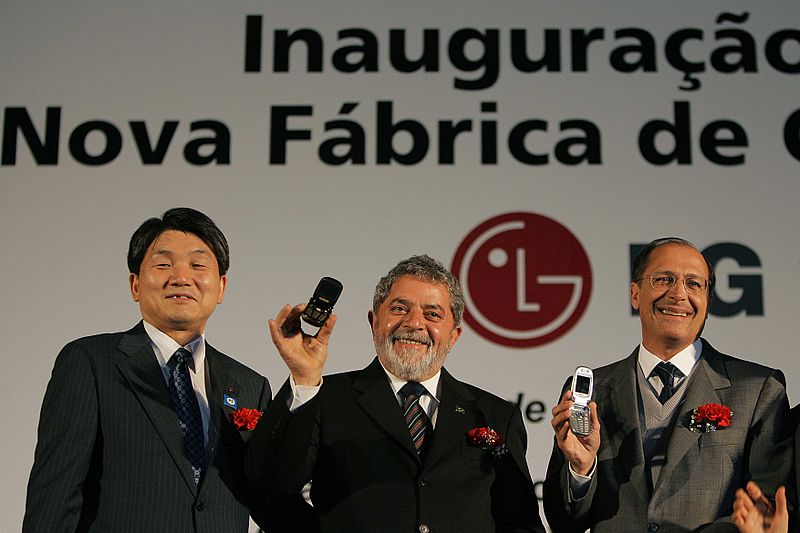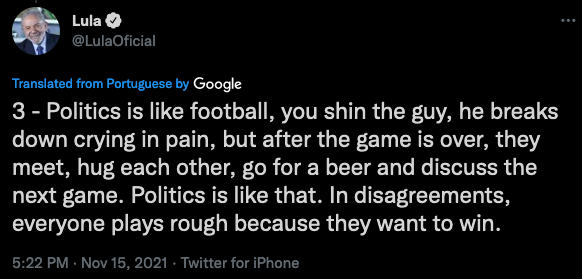These are terrible, terrible days. A young Ukrainian woman described to me, with tears in her eyes, the conditions for her bed-ridden grandmother, for relatives and friends, some with toddlers and babies, in many parts of Ukraine. Any remaining uncertainties I may have had on one question disappeared; this war is a crime, an awful crime; it is correct that so many are demonstrating and demanding an end to it.
But in marching and demonstrating, in Germany, the U.S.A. or elsewhere, it would be wise to look carefully at some who are next to you, or up there on the speakers’ platform, waving blue and yellow flags and loudly praising resistance, democracy, people’s sovereignty and other fine goals. Am I mistaken in wondering: didn’t I see some of them before, actively opposing just such goals? And don’t some of them smell suspiciously of luxurious skyscraper corner offices, or of that giant geometrical structure near the Potomac, or of the Bender Block, its Berlin equivalent?
Was it not their forebears who began the 20th century by wresting Cuba, Puerto Rico and the Philippines from Spain but then, like Gen. Jacob Smith, when facing fighters who had expected freedom, gave his soldiers the commands: “I want no prisoners. I wish you to kill and burn, the more you kill and burn the better it will please me. I want all persons killed who are capable of bearing arms in actual hostilities against the United States.” Asked by his major: “Are 10-year-olds really to be designated as capable of bearing arms?” – “Yes,” was his answer.
In 1935 Marine General Smedley Butler told how he kept up the tradition: “I spent 33 years and four months in active military service … most of my time as a high-class muscle man for Big Business, for Wall Street and the bankers. In short, I was a racketeer, a gangster for capitalism. I helped make Mexico and especially Tampico safe for American oil interests in 1914. I helped make Haiti and Cuba a decent place for the National City Bank boys to collect revenues in. I helped in the raping of half a dozen Central American republics for the benefit of Wall Street. I helped purify Nicaragua for the International Banking House of Brown Brothers in 1902-1912. I brought light to the Dominican Republic for the American sugar interests in 1916. I helped make Honduras right for the American fruit companies in 1903. In China in 1927 I helped see to it that Standard Oil went on its way unmolested.”
After August 1945, with much of the world in ruins, well-tailored or smartly-uniformed gentlemen extended such efforts worldwide. North Korea was bombed so ferociously from 1950 to 1953 that hardly a building over one storey high remained standing, big dams were destroyed, three million people were killed. Beginning a decade later, 400,000 tons of Napalm were sprayed on Laos, Cambodia and Vietnam. Again, some three million were killed, rain forests destroyed, generations of misshapen babies were predetermined.
Highly-educated cloak-and-dagger men spread out worldwide. In Iran, in 1953, the CIA organized a coup to depose popular, democratically-elected premier Mossadegh, who had tried to end foreign exploitation of Iran’s oil resources. He ended up under life-long house arrest; the re-installed Shah was upheld in his bloody rule for 26 more years.
In 1954, back in Latin America, 100 CIA agents spent up to 7 million dollars for “psychological warfare and political action” against Pres. Jacobo Árbenz of Guatemala, who had angered CIA-Director Allen Dulles and his brother, Secretary of State John Foster Dulles, by requiring the United Fruit Company (now Chiquita), in which both were financially involved, to sell large areas of unused land to poor farmers who had no land. A small but well-equipped army invaded, ousted Arbenz and put the CIA man on top. The land reform was canceled, so was the literacy campaign. In the years that followed thousands were jailed, tortured and killed; countless Maya villages were decimated.
U.S. assassination manuals compiled in Guatemala were then used in nearly every country of Latin America and beyond. Rafael Trujillo in the Dominican Republic in 1961 and Ngo Dinh-Diem in Saigon in 1963 were both killed. Especially tragic was the torture, murder, dismemberment and dissolution in acid of Congo’s poet-statesman Patrice Lumumba in 1960, in CIA-connivance with the slightly quicker Belgian colonialists. Equally sad was the death of Salvador Allende in his burning government palace in Chile in 1973. Henry Kissinger, who helped with the plans, made his views of democracy clear: “I don’t see why we need to stand by and let a country go communist due to the irresponsibility of its people. The issues are much too important for the Chilean voters to be left to decide for themselves.” General Pinochet, in connivance with the CIA, the State Department and Chilean torture and killer squads did the rest.
But the CIA, despite all efforts and Mafia aid, failed in 638 attempts to assassinate Fidel Castro, though approved by eight presidents, and including a bombing attempt in a crowded stadium.
Until 1990 such attacks were largely motivated by a deep hatred of anything even slightly connected with that fearsome menace, socialism – and its threatened confiscation of the millions – billions today – which they or their fathers had piled up thanks to the muscles, brains and sacrifices of the other 99% of the world’s population. Not a penny should be taken from them, they determined, and this made them mortal enemies of the USSR and the so-called Eastern Bloc.
But after 1990, with this motivation and rationale gone, others were needed. “Human rights” were again invoked, sometimes in curious ways. The journalist Lesley Stahl interviewed Secretary of State Madeleine Albright about U.S. sanctions against Iraq: “We have heard that a half million children have died, that’s more children than died in Hiroshima. .. Is the price worth it”?
Albright’s reply: “I think this is a very hard choice, but the price – we think the price is worth it.“
This soon included more killing from the skies, long before Kyiv or Kharkiv. In 1991, during the Persian Gulf war, the destruction of the Amiriya bomb shelter in Baghdad killed 408 civilians, most of them burned alive. In 1999 the “human rights” of Kosovo were bravely defended by NATO’s bombing of civilians in Serbia, now at last with the help of a unified Germany.
Then came 9/11 and the need for a full-scale “war against terror,” twenty years of death and destruction in Afghanistan and, in 2003, more frightful bombing of Iraq. 29,200 “Shock and Awe” air strikes during the initial invasion, 500-pound bombs on densely-populated cities meant hundreds of thousands of deaths of which “46 per cent were girls and women and 39 per cent children.”
Some may recall 12-year-old Ali Abbas, who dreamt of becoming a doctor. Then the bomb hit. Unlike both parents and his siblings he survived, but he no longer had arms, just a pair of stumps protruding from each small shoulder. Journalists reported his agonized shrieking as doctors huddled over him – and his later question: “What did we do to the Americans?”
Every single wartime death or wound is terrible, every missile, every bullet is unnatural. There are too many similar tragedies now in Ukraine. Yet, while writing this, I find myself thinking: despite each and every tragedy – thank goodness that Ukraine has not been hit like Iraq in 2003, with the death of hundreds of thousands. Yet alas, while I see the Brandenburg Gate lit up with Ukrainian blue and yellow, I recall no Iraqi colors there in 2003, nor those of Palestinians in 2014 after the death of 547 children during the bombing of Gaza.
In the years that followed, as military campaigns in Iraq, Afghanistan and elsewhere were mired down or lost, symbols, slogans and catchwords about terror wore thin, the fearfulness of words like Islamism, communism, socialism eroded, like Bolshevism and anarchism in earlier eras. The gargoyle faces, the grayed grimaces of Reagan’s Evil Empire warnings in 1983 needed replacement, for the pressures remained. Putin’s angular face and physique often have to suffice – or is the yellow peril back in play? And what are those pressures, refurbished but still very real?
Some are easy to call by name: Lockheed, Northrop-Grumman, Raytheon, friendly German rivals like Rheinmetall, Krupp, Maffei – and a further limited list. They earn their billions by producing and selling their products, which must constantly be multiplied, replaced – or used. Thus, while military actions by Putin or any others may be treated by such folk with loud cries of condemnation or sympathy for the victims, behind their dampened Kleenex hankies we can sense their jubilation as military budgets soar, now nearly $780 billion a year in Washington, and the German government, previously tugged one way by traders with Russia or China, now being overwhelmed by the military monopolies, ambitious expansionists and devoted Pentagon friends who, since the march into Ukraine, have gained the upper hand. The military budget now aims at topping the 50 billion euro level, with ever more spending for jets, frigates, armed drones and more personal armor as well; after all, those patriotic lads or lasses in uniform must not be neglected, but always sent well-armored to their deaths.
And how many have the courage to disapprove of all of this? To vote against it, in the Capitol or the Bundestag? Only a very, very few, now angrily disqualified or ignored.
Not only manufacturers of armaments are waving blue-yellow flags with one hand and concealing profit calculations with the other. If their real hopes come true, if Putin’s move goes awry and ends up with a regime change in Red Square, as in Maidan Square in 2014 but far bigger, what new opportunities would be opened up! Many doors were opened thirty years ago when a drunken, easily manipulated marionette was installed in the Kremlin! But just think of the chances with a more permanent pawn! Many are surely dreaming of wide new Eurasian monoculture, of unlimited raw materials, new markets, skilled proletarians. Tyson and Cargill, Bayer and BASF, GM and Daimler, Nestlé and Unilever, Murdock and Springer, Facebook und Amazon must certainly be checking electronic atlases for maps reaching from Smolensk to Vladivostok – and across the Amur, too, where great multitudes could then be reached so much more easily.
What this all adds up to is a continuing hope for world hegemony – always with God’s help of course. Senator Mitt Romney, once a candidate for the presidency, put it clearly:
“God did not create this country to be a nation of followers. America is not destined to be one of several equally balanced global powers. America must lead the world, or someone else will. Without American leadership, without clarity of American purpose and resolve, the world becomes a far more dangerous place, and liberty and prosperity would surely be among the first casualties.”
Supporting this God-given path are not only big-biz executives, financiers and military brass, but also a subservient media, obedient politicians aiming at highly-paid jobs when they leave politics, a number of labor leaders and power holders in academia. They all form the Establishment, one quite similar in all so-called free market democracies, except that for over eighty years the USA sector has asserted its role in the pack as alpha wolf.
In a broadcast with Amy Goodman on March 2 2007 one vector of a world-wide program was revealed by General Wesley Clark, a memo by then Defense Secretary Wolfowitz which described “how we’re going to take out seven countries in five years, starting with Iraq, and then Syria, Lebanon, Libya, Somalia, Sudan and finishing off with Iran.”
The timetable didn’t work out exactly – timetables often don’t – but was close enough. And If Iran could really be tamed once again, as in 1952, Georgia would then be close. And Russia as well.
Another vector was even more crucial. When East German annexation was agreed upon in 1990, Soviet army withdrawal was matched by the American and West German verbal promise to a very trustful Gorbachov that NATO would never expand past the Elbe River into East Germany or beyond. The promise was soon broken. The Pentagon-based NATO moved with its military technology into East Germany and on to Poland, Czechoslovakia, the Balkans, the Baltic countries, thus surrounding all but the southern flank of European Russia with an increasingly tight, hostile ring, featuring broadened, strengthened highways and rail lines pointing eastwards, potential missile launchers in Poland, swift jet planes, fueled and polished, in German and Belgian hangars, with nuclear bombs waiting nearby, and annual aggressive military maneuvers along Russian borders. NATO was spending 1110 billion on armaments, Russia 62 billion.
And then north and south were linked. In 2013 the Ukrainian president, no angel, faced a choice between the unsteady but undeniable advantages of economic cooperation with Russia, its main energy supplier, or biting at the bait of promised western prosperity, with all the luxuries it symbolized for many Ukrainians, especially in its western regions.
The US-American leadership decided to move ahead. No doubt they were thinking of fat dividends and even more about closing that tight ring, or noose, around Russia and gaining control of Sevastopol, the big naval base on the Black Sea. After spending five billion dollars or more on propaganda and organizing anti-Russian groups and parties, it re-animated its earlier “orange revolution.“ Joining with openly pro-fascist groups – with swastikas, Heil Hitler salutes and all, it managed the ouster of the elected president, who had to flee to safety. In a famous decision, revealed in a hacked telephone call between the U.S.A. ambassador in Kyiv and Victoria Nuland, Assistant Secretary of State, the American puppet Arseny Yatseniu, referred to endearingly as “Yats“ by Nuland, was installed by her as prime minister.
Leadership positions in Ukraine have changed several times since then, as the influence of varying oligarchs altered. Some things remained constant. Russian speakers were discriminated against and suppressed, resulting in the vote of a great majority in Crimea to become part of Russia once again – as they were until 1954. Two Russian-speaking eastern provinces defied the anti-Russian pressures and broke away, with Moscow support. Armed Ukrainian militia units, some with openly pro-fascist symbols on their uniforms or skins, kept battering against them. Perhaps it was their strength which prevented the Kyiv government from abiding by the peace agreements of Minsk, in which Paris, Berlin, Moscow and Kyiv had agreed on seeking solutions, with partial autonomy for the Russian-speaking provinces, or was it pressure from Washington and local oligarchs which moved the current president, Volodymyr Zelenskyy, at first seemingly in favor of negotiations, to back out?
Since that goal of world hegemony in many wealthy American brains, Republican and Democrat, was never abandoned, and only Russia and China stood in the way, Ukraine was clearly being built up as a counterforce against one such barrier, indeed as a ramp for further action. Which leads us to 2022.
Putin clearly disapproved of any ramps close to his borders. He hardly needed to leaf in the history books for the years 1812, for 1918-1921, but especially for 1941-1945 to strengthen his resolve. With the increasing threat from an enlarged, aggressive NATO, he could not possibly ignore a Ukraine eagerly pushing to join up as soon as possible, after it had already joined in NATO wars in both Iraq and Afghanistan. All the offers Russia made to negotiate the issues – above all a bar to Ukraine officially joining NATO – were rejected in the West as “non-starters” and accompanied by further waves of recriminations and new sanctions.
Was this extreme hostility by media and politicians, with its implied threats (and its actual incidents, as in Syria), the reason for Putin’s decision to invade Ukraine? Despite TV hours and piles of paper and ink expounding about it, I see absolutely no basis for warnings that Putin has plans to “expand his empire”; I have not seen a single word threatening Finland, Poland, Romania or the Baltic trio, which are often loudest in exhortations. And Germany? The idea of Russia attacking Germany is fully unthinkable – though not enough to hinder big armament expansion plans in Berlin.
In the past Russia was systematically threatened and also attacked – and is surrounded by a world with over 750 American military bases, with an American military budget bigger than the next ten countries combined, and with four times as many NATO soldiers as Russians in uniform. Even when Russia deployed troops outside its borders, bitter as these occasions were, they were only in countries which were on its borders, and hence – if under unfriendly control – were viewed as potential threats as much as Russian or Chinese deployments in Mexico or Canada would be viewed in the U.S.A. Ukraine definitely borders Russia – its heartland. Militarily, the USSR and Russia were always basically on the defensive, not on an offensive track.
And yet its soldiers, tanks and planes have invaded Ukraine, with results just as horrible for those affected, even if not on the same scale, as American attacks in the Philippines and Vietnam, Nicaragua and Iraq – or in two of the worst crimes ever committed by humankind – at Hiroshima and Nagasaki. We cannot look into Putin’s mind, nor know of possible threats he seems to have considered immediate. We must strictly reject any nonsense disputing the will of most Ukrainians to remain independent and sovereign – though not to become part of a NATO-led threat.
Was this war then a result of Putin’s fears of some planned NATO provocation or attack? Was it because of an apparent change in President Volodymyr Zelensky’s seemingly more balanced, peace-minded position, more interested than recent predecessors in getting along with Russia, to a more aggressive stance, rejecting the Minsk agreement and any others of its kind? Whatever the reason, Putin evidently concluded that his decision was inescapable. Was it? Can actions of this kind ever really be inescapable?
The invasion, for whatever reason, has not only caused great misery in Ukraine, but also given an immense steroid push to the forces on the political right, the traditional Russia-haters, those thinking constantly of protecting and increasing their fortunes, and those who want no peace, but only victory, any victory over Russia. They want to demolish not only the reign of Putin but Russia in general as a barrier to capitalist expansion, to a hegemony ruled from Washington, Wall Street and the Pentagon.
It is these people who are demanding no-flight zones; 27 former Pentagon and State Department officials and a former top NATO military commander joined Volodymyr Selensky in calling for a no-fly zone, although they know full well what that means. As even Senator Marco Rubio of Texas said of the demand: “It means starting World War III.”
On the other hand, the march into Ukraine has caused saddening collateral damage, another likely season with the splintering and weakening of progressive forces who work for peace and whose growth is becoming almost desperately necessary in the face of a growing fascistic menace.
Perhaps more explanatory background facts will emerge some day. Today, however, I feel most clearly; I am against killing and destruction. I will therefore join in a march for peace – but not in step with the greedy, violence-hungry forces who have taken up this issue to pursue their own disastrous goals. They are not my allies and I fear the atmosphere of hatred now being cultivated, even against books and sopranos. It is getting dangerous. My over-riding hope is that current talks may lead to peace, to an end of death and destruction, and to the repair and renewal of all efforts to build a world without exploitation, without aggrandizement, without aggression, without war.
